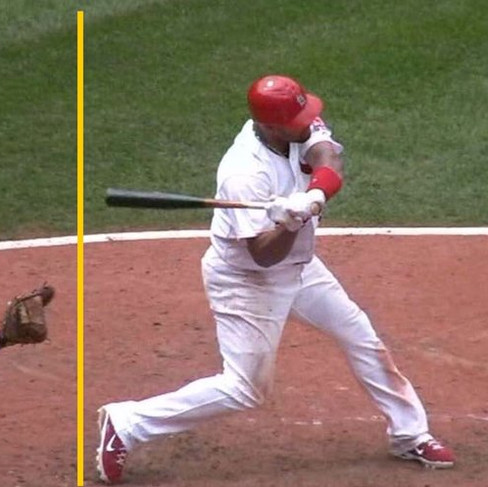LONG VS. SHORT SWING
- elitediamondperfor
- Apr 11, 2022
- 3 min read
Go to any baseball game from little league through professional baseball and you will probably hear a coach tell a player to shorten their swing. I hear players all of the time talking about trying to shorten their swings. So today I wanted to discuss what the difference between a short and long swing is, why being on either end of the swing length spectrum can be bad and some drills to work on swing path with.
SWING LENGTH DEFINED Swing length is basically the length that the barrel of the bat has to travel to get to the ball. This is represented by the blue line in the picture below. The shorter the distance, the shorter the swing, longer distance means a longer swing.

WHAT DO WE WANT SHORT OR LONG? Like just about everything else in hitting, somewhere in the middle. Unfortunately, most coaches think that every player needs to shorten their swing.
BENEFITS OF A LONG SWING A longer bat path when done correctly, will come through the zone and contact point with much more bat speed. A longer path can also allow the bat to get on the plane of the incoming pitch sooner and increase the time the bat is in the hitting zone, thus increasing chances of making contact.
DOWNSIDE OF A SWING THAT IS TOO LONG The biggest weakness of a hitter with a long swing is that they usually have to commit to the ball sooner. This can leave the hitter more susceptible to off speed pitches. Also, a hitter with too long of a swing risks being late on fastballs if they don’t initiate the swing early enough.
BENEFITS OF A SHORT SWING More time to react to the pitch. The shorter the path of the bat, the more time a hitter can wait to commit to swinging at the ball.
DOWNSIDE OF A SWING THAT IS TOO SHORT Often times players who shorten their swings too much will not be able to drive the ball due to a lack of bat speed creation. In addition, many times players who shorten too much can display an impaired bat path that does not work up enough through the zone.
WHERE COACHES GO WRONG
Have you ever heard a coach tell a player that their swing was too short? Probably not. However, while I do see many kids who have swings that are too long, I see just as many kids with swings that are too short. Let me explain.
Most coaches think that shorter is better. However, this is just not the case. Most coaches advocating for a shorter swing will throw out cues such as “point a to point b”, “take the shortest path possible”, etc. Drills like this tee will help players develop this sort of swing.

Yes, the shortest path is straight to the ball, however, this is not what good hitters do. Good hitters allow the bat to work behind them for a few reasons. Look at the pictures below:
In the first three pictures, the barrel of the bat is working behind the hitter, getting underneath the ball and as shown by picture 4, working in a circular path, not straight. This is a constant among good hitters. Every high level hitter will take this elliptical path to get to the ball to both increase bat speed as well as ensuring the bat gets on plane with the pitch as deep as possible.
HOW DO I KNOW IF MY SWING IS TOO LONG? Although every major league hitter that I have ever studied takes a circular path to get the the ball, they also usually display a limit to how long that path is. After all, if they took too long of a path, they would get beat especially by the increasing fastball velocities in the big leagues. Take a look at the pictures below. I have drawn a line about six inches behind the hitters back foot in their stance. What do we notice? The bat doesn’t cross that line. They are allowing the bat to work behind them and get into the zone early, but in the shortest possible route to achieve this. If the bat crosses behind this line, that is what I would consider a long swing.
Drill to work on swing length












